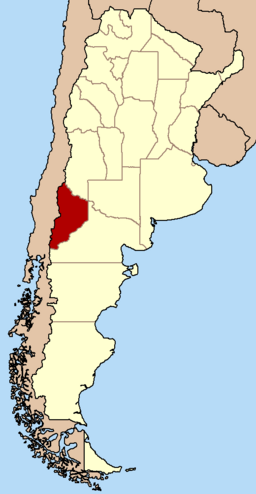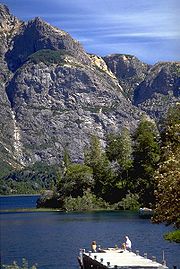Neuquén Province
| Neuquén | |||
| Province | |||
|
|||
| Divisions | 16 departments | ||
|---|---|---|---|
| Capital | Neuquén | ||
| Area | 94,078 km² (36,324 sq mi) | ||
| Population | 474,155 (2001) | ||
| Density | 5.0 /km² (13 /sq mi) | ||
| Governor | Jorge Sapag | ||
| - Senators | Nanci Parilli, Marcelo Fuentes, Horacio Lores | ||
| ISO 3166-2 code | AR-Q | ||
| Demonym | Neuquino | ||
 |
|||
| Website: http://www.neuquen.gov.ar | |||
Neuquén is a province of Argentina, located in the west of the country, at the northern end of Patagonia. It borders Mendoza Province to the north, Rio Negro Province to the southeast, and Chile to the west. It also meets La Pampa Province at its northeast corner.
Contents |
History
The Neuquén Province receives its name from the Neuquén River. The term "Neuquén" derives from the Mapudungun word "Nehuenken" meaning drafty, which the aborigines used to refer to this river. The word, without accentuation, is a palindrome.

Inhabited by Pehuenches, Tehuelches and Mapuches, the territory was not explored by the Conquistadores until late in the 17th century. In 1670 another priest, Nicolás Mascardi, founded the Jesuit mission Nuestra Senora de Nahuel Huapi.
In 1879 Julio Argentino Roca started the infamous Conquest of the Desert (Conquista del Desierto) that finally broke the aboriginal resistance. In 1884 the Patagonia's political division was restructured and the Government of Neuquén acquired its current boundaries. The capital of the province moved several times to Norquín (1884-1885), Campana Mahuida (current Loncopué) (1885-1888), Chos Malal (1885-1901), and finally Confluencia currently known as Neuquén.
At the beginning of the 20th century the railway reached the city of Neuquén, and a new irrigating system was finished facilitating the production and later transportation of crops. Petroleum was found in Plaza Huincul in 1918, giving to Neuquén a new push forward.
The territory was named province in June 15 1955, and its constitution is declared in November 28 1957. The University of Neuquén was founded in 1964, and the University of Comahue in 1971.
Like in many of Argentina's smaller provinces, local politics have long been dominated by a single family, presided over by a Caudillo. Neuquen's case is unique in that, though often ruled by a Caudillo, the family he headed was not a colonial-era feudal landlord; but, rather one of prosperous immigrants.
Migrating to Argentina around 1910, the Sapag family eventually made their home in Neuquen, whose dry, fertile mountain valleys and orchards were reminiscent of their native Lebanon. Becoming staunch supporters of Juan Peron following his efficient handling of reconstruction related to the devastating 1944 quake in nearby San Juan Province, the immigrants' eldest son, Felipe Sapag, soon became politically prominent. Elected governor in 1962 on the Justicialist (Peronist) ticket, a coup against progressive President Arturo Frondizi that March prevented Sapag from taking office. Eventually becoming governor in 1973, Sapag emphasized public works and, politically, trod a careful middle course in an era when left and right-wing Peronists jockeyed for influence over the dying Peron and his widow, the hapless Isabel Peron.
Removed as governor following the violent, March, 1976, coup against Mrs. Peron, Sapag lost two of his four children to the dictatorship, the most violent, by far, in modern Argentine history. Overwhelmingly returned to power following Argentina's 1983 restoration of democracy, Sapag presided over one of the country's most stable economies in an era when Argentina was reeling from the effect of the dictatorship's ruinous economic policies, retiring in 1991.
Geography and climate

The province's limits are set by the Colorado River to the Northeast, separating it from the Mendoza Province, the Limay River to the Southeast facing the Río Negro Province, and the Andes mountain range to the west, separating it from Chile.
There are two main distinctive landscapes; the mountainous fertile valleys with forest on the West, and the arid plateau with fertile land only near the basins of the rivers on the East, mainly the Limay River and Neuquén River.
The lacustrine system includes other less important rivers such as Aluminé River, Malleo, and Picún Leufú River, and a series of lakes including the Nahuel Huapi Lake (550 km²), shared with the Río Negro Province, the Aluminé Lake (58 km²), Lácar Lake (49 km²), Huechulaufquen Lake (110 km²), Lolog (35 km²), Traful, Hermoso, Quillén, Ñorquinco, Tromen and Falkner.
The weather is continental and cold, with temperate summers, and in the arid regions a wide difference in temperature between day and night. There is also a big contrast in humidity, with regular precipitations of up to 4.000 mm in some regions of the Andean part of the province.
The province is home of the magnificent Arrayanes (Luma apiculata) forest at the Los Arrayanes National Park. Other National parks include Lanín National Park and the Lanín extinct volcano, the Nahuel Huapí National Park shared with the Río Negro Province, and the Laguna Blanca National Park.
Economy

Neuquen is one of Argentina's most prosperous provinces, its estimated US$7 billion economy in 2006 (the country's eighth largest, despite its small population) generated a per capita income of US$14,700, Argentina's fourth highest and two-thirds above the national average.[1]
No province in Argentina, however, is as dependent on any one sector as is Neuquen's. Roughly half its output is accounted for by its mining and extractive sector, mainly on account of its massive gas and petroleum production, the most important in Argentina.
The province generates a significant part of Patagonia's electric power through the hydroelectric plants of Piedra del Águila, El Chocón, Pichi Picún Leufú, Planicie Banderita (in the Cerros Colorados Complex), and Alicurá. The town of Arroyito hosts the only heavy water plant in the country.
Another important activity is the production of apples, pears, peaches and others, specially in the Alto Valle area, shared with Río Negro.
The piquetero movement (organizations of unemployed workers) was born in Neuquén in the 1990s, during the presidency of Carlos Menem.
Tourism

- See also Tourism in Argentina article
Destination of many Argentines and foreigners, the province has many and varied options for winter and summer; San Martín de los Andes, Villa La Angostura, Camino de los Siete Lagos, Los Arrayanes National Park, Lanín National Park, Nahuel Huapí National Park, Laguna Blanca National Park, and the Copahue hot baths are just some of them. For the winter season, there are the ski centres of Chapelco, Cerro Bayo and Caviahue.
Many explore the lake district region of Southwestern Neuquén that stretches into Río Negro and Chubut Provinces. Another form of tourism is the fishing excursions of mainly the trout, where spinning, trolling and fly casting in the Limay and Neuquén rivers, but also in different smaller streams.
There were a number of dinosaurs in the area, of which the bones of a 95 million years old Argentinosaurus are in dispay at the Carmen Funes Museum in Plaza Huincul.
Political division
The province is divided in 16 departments (Spanish: departamentos).



| Map | Departament | Capital |
| Aluminé | Aluminé | |
| Añelo | Añelo | |
| Catán Lil | Las Coloradas | |
| Chos Malal | Chos Malal | |
| Collón Cura | Piedra del Aguila | |
| Confluencia | Neuquén | |
| Huiliches | Junín de los Andes | |
| Lácar | San Martín de los Andes | |
| Loncopué | Loncopué | |
| Los Lagos | Villa La Angostura | |
| Minas | Andacollo | |
| Ñorquín | El Huecú | |
| Pehuenches | Rincón de los Sauces | |
| Picún Leufú | Picún Leufú | |
| Picunches | Las Lajas | |
| Zapala | Zapala |
References
External links
|
||||||||||

